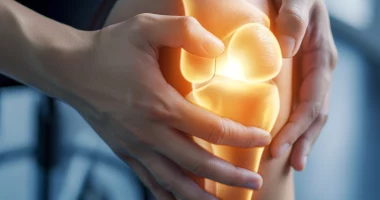Hemarthrosis
What’s that?
Hemarthrosis is the pouring of blood into the joint cavity, which, in most cases, is the result of traumatic injury.
About the disease
Hemarthrosis most commonly affects the knee joint, which can be easily traumatized. In addition, hemorrhage can occur in other large and medium-sized joints, such as the right/left hip, elbow, shoulder, and ankle. Hemarthroses of small joints (fingers and toes) are rare.
The immediate mechanism of hemarthrosis is thought to be vascular rupture, causing blood to flow unimpeded into the intra-articular space until a blood clot forms.
The main manifestations of hemarthrosis are pain in the affected joint and violation of its functional state. To suspect the corresponding pathological process, the doctor is helped by a detailed examination and palpation of the problematic joint (swelling, tissue tension, and soreness are determined). The final diagnosis is established based on additional examination, which includes ultrasound and X-ray scanning of the joint. In complex clinical cases, computer or magnetic resonance imaging may be performed, as well as diagnostic arthroscopy (introduction of endoscopic instruments into the joint cavity and visualization of intra-articular changes).
Both conservative and surgical methods can be used to treat hemarthrosis. The treatment program choice is personalized for each patient, taking into account the degree of pathological process and the initial state of the joint. The main approaches are resting the injured joint (immobilization), application of cold, puncture and aspiration of blood (in case of extensive hemorrhage), and intra-articular injections of different therapeutic approaches (anti-inflammatory, metabolic, etc.).
Types
Hemarthrosis is classified by localization – taking into account which joint has been hemorrhaged.
According to the activity of the process, two forms are distinguished:
- sharp;
- recurrent.
Symptoms of hemarthrosis
The main symptoms of hemarthrosis are:
- increase in the volume of the affected joint;
- painful sensations, which are more intense the more blood poured into the joint cavity;
- impaired mobility of the joint and the appearance of instability;
- dysfunction, for example, in hemarthrosis of the knee, support of the leg causes significant pain, resulting in reflexive flexion of the joint.
Causes of hemarthrosis
The following conditions are the leading causes of hemarthrosis:
- contusions due to a direct hit or fall;
- professional sports, especially injury-prone sports;
- a fracture of the bones inside the joint;
- medical intra-articular interventions (the risk is increased if the methodology of the procedure is not followed or if the individual characteristics of the course of the vessels differ from the typical blood supply of the joint);
- blood clotting disorders with a tendency to bleeding (the most common pathology is hereditary hemophilia).
In acute joint trauma, as a result of ruptured blood vessels, blood spills into the joint cavity. Blood and its decay products, which accumulate in the joint, have a high oxidative capacity, disrupt tissue metabolism, and cause hypoxia and changes at the molecular level not only of intra-articular formations but also of periarticular tissues, which subsequently leads to the formation of adhesions in the sliding apparatus, preventing the full restoration of joint function. Therefore, it is important to prescribe treatment with such risks in mind.
Diagnosis
According to clinical guidelines, the following examination methods may be used to diagnose hemarthrosis in addition to an objective examination of the joint:
- Ultrasound. Ultrasound scanning allows you to determine the severity of hemorrhage and the nature of the consequences provoked by it.
- X-ray scan. X-ray examination helps to detail the state of bone tissue (in turn, ultrasound is more informative for evaluating soft tissue formations).
- CT and MRI. These methods are used in complex clinical cases when the detected radiologic or echographic signs are insufficient to establish an accurate diagnosis and determine the optimal treatment tactics.
Hemarthrosis treatment
For the treatment of traumatic joint injuries in children and adults, such methods as joint puncture followed by immobilization with a plaster cast (for two weeks or more) can be used. Modern traumatology widely uses innovative methods of minimally invasive treatment.
Conservative treatment
In case of minor hemarthrosis, the affected joint is immobilized and cold therapy is applied. If inflammatory changes develop, corticosteroid drugs, which can be administered systemically or locally (intra-articular injections), are prescribed to control them.
Many treatment options have been proposed to restore the lost function of the joint. Recently, intra-articular PRP therapy has been successfully applied, which involves the introduction of a specially prepared patient’s plasma, a concentrate of platelets, into the joint cavity. The latter contains growth factors that stimulate the lysis of excess blood and the natural regeneration processes of damaged tissues. If necessary, platelets can transform into muscle, cartilage, and bone tissues, which contributes to the complete restoration of the anatomical and functional state of the joint.
Surgical treatment of hemarthrosis
The main type of surgery for hemarthrosis is the puncture of the affected joint. The doctor punctures the skin at certain points and introduces special instruments into the joint cavity. First, the intra-articular structures are examined, and then the evacuation of the blood is carried out. Then, the cavity is treated with antiseptics, which reduce the risk of inflammatory complications and prevent the formation of adhesions.
All these treatment options are available in 940 hospitals worldwide (https://doctor.global/results/diseases/hemarthrosis). For example, Arthrocentesis can be done in 17 clinics across Israel for an approximate price of $1,530(https://doctor.global/results/asia/israel/all-cities/all-specializations/procedures/arthrocentesis).
Rehabilitation after hemarthrosis
Rehabilitation after hemarthrosis involves a course of physical procedures that have a complex effect on the injured tissues and contribute to their full recovery. Physiotherapeutic methods help to improve microcirculation, stimulate metabolic processes, and reduce the risk of fibrosis.



